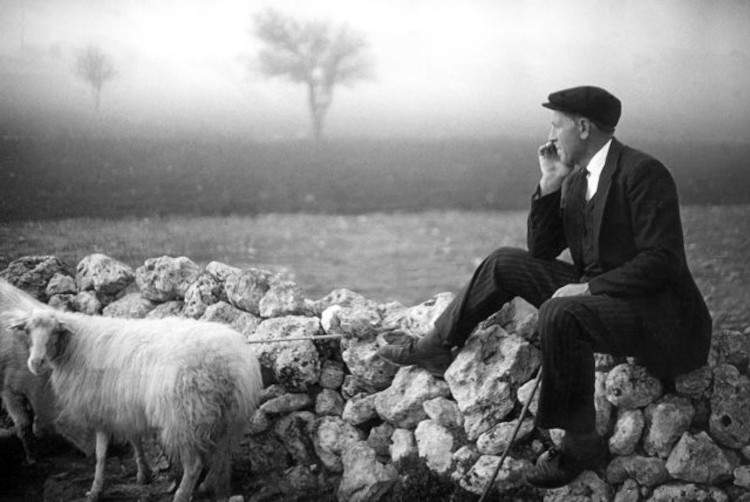From June 23 to October 20, 2023, Castello Ursino in Catania is hosting the major exhibition Ferdinando Scianna. I Remember You Sicily, curated by Paola Bergna and Alberto Bianda, promoted and produced by the City of Catania and Civita Sicilia.
A selection of more than eighty photographs printed in different formats will be on display, tracing the entire career of the great Sicilian photographer. The exhibition unfolds along an articulated narrative path, built on different chapters and various modes of black and white setting in order to highlight the close ties that unite him to his homeland. Through subjects, images, places, rituals, festivals and customs, the visitor can learn about and explore the land so dear to the photographer.
The exhibition begins with a tribute to his hometown of Bagheria, which is ready to celebrate its famous fellow citizen on the occasion of his first 80 years that will fall on July 4, then the shots dedicated to Marpessa. When, towards the end of the 1980s of the last century, Ferdinando Scianna decided to make his entrance into the fashion world many were surprised. Called by the then-emerging Dolce & Gabbana to represent their style, the Sicilian photographer began an extraordinary partnership with the very young Dutch model Marpessa Hennink, shooting her in Mediterranean atmospheres charged with a mysterious and sensual charm in a continuous balance between reality and fiction, archaism and modernity, becoming one of the artist’s muses.
Always one of the best known names on the national and international scene, Ferdinando Scianna is among the great masters of photography, not only Italian. The first Italian photographer to be part of the Magnum agency since the early 1980s, he had many ties with personalities from the world of art and culture; among them Leonardo Sciascia, to whom an entire chapter of the exhibition is dedicated and to whom Ferdinando Scianna was linked by a close friendship.
They met by chance after Sciascia, accompanied by a mutual friend, visited Scianna’s first photography exhibition, set up at the Bagheria culture club, when Ferdinando was only 20 years old. The writer was impressed by the young photographer’s black-and-white shots. Ferdinando was not there but Sciascia left a generous message of esteem for him. Therefore Scianna decided to visit him at his home in Racalmuto: it was love at first sight, “at the age of 20 I had found the key person in my life.” From this meeting came their first collaboration: Feste religiose in Sicilia (1965), with photos by Scianna and texts by the writer. With this volume, which was a political and literary case in Italy, Ferdinando won the Nadar Prize in 1966.
Sciascia and Scianna worked together on several other publications such as Les Siciliens (1977), La villa dei mostri (1977), and Ore di Spagna (1988). The two were lifelong friends as evidenced by more than a thousand mostly unpublished photographs taken during their summers in Racalmuto and on their many trips together. A family album that portrays Sciascia in a private dimension because “until he gave me the terrible offense of dying, he remained my paternal angel.” It was a pivotal relationship in the life of Ferdinando Scianna who writes, “friendship is like an exchange of the keys to each other’s individual citadels, it is the acquisition of the mutual right to use each other’s eyes, minds, hearts.” A small part of these photos became a book: Scianna photographs Sciascia (1989), which the writer managed to see shortly before his death.
The exhibition has a layout and selection of images specially designed for the Castello Ursino venue, with video and graphic contributions, to celebrate the relationship between the area and the great Sicilian photographer.
“Photographing Sicily for me is almost a verbal redundancy. I started photographing around the age of seventeen and Sicily was there. I started photographing because Sicily was there. To understand it and through photographs to try to understand, perhaps, what it means to be Sicilian,” Scianna said
Ferdinando Scianna began his passion for the language of photography in the 1960s, recounting in images the culture and traditions of his home region, Sicily.
His long artistic journey winds through various themes - current events, war, travel, popular religiosity - all linked by a single thread: the constant search for form in the chaos of life. In more than sixty years of stories, there is no shortage of suggestions: from Bagheria to the Bolivian Andes, from religious festivals (the debut of his career) to experience in the fashion world. Then reportages, landscapes, his thematic obsessions such as mirrors, animals, things.
Of his work Ferdinando Scianna writes, “as a photographer I consider myself a reporter. As a reporter my fundamental reference is that of my master par excellence, Henri Cartier-Bresson, for whom the photographer must aspire to be an invisible witness, who never intervenes to modify the world and the instants that he reads and interprets of reality. I have always made a clear distinction between found and constructed images. I have always considered that I belong to the side of photographers who find images, those that tell and tell you, as in a mirror. Even fashion photographs I have always found them in the hazard of encounters with the world.”
Hours: Daily from 10 a.m. to 7 p.m.
Image: Master of Water, 1964. ©Ferdinando Scianna
 |
| A major exhibition in Catania dedicated to Ferdinando Scianna and his Sicily |
Warning: the translation into English of the original Italian article was created using automatic tools. We undertake to review all articles, but we do not guarantee the total absence of inaccuracies in the translation due to the program. You can find the original by clicking on the ITA button. If you find any mistake,please contact us.